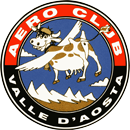A brief history
The airport’s existence owes itself to the drive and enthusiasm of a group of devotees who founded the Aosta Valley Aeronautics Association in 1956 while awaiting recognition from Aero Club d’Italia.
They were able to create such interest and draw so much attention to the issue of flying that the regional government was compelled to begin building the airport. Towards the end of 1958, even before the construction of the runway was completed, the Association, which had welcomed nearly two hundred members in the meantime, became a federated member of Aero Club d’Italia under the name Aero Club Valle d’Aosta. The first flights took off from the new airport on 10 May 1959, and training activities began at practically the same time. From the outset, the regional government entrusted management of the airport to the aero club.
One of the first pilots from the Aosta Valley to obtain a pilot’s licence was the young councillor for Public Education, Corrado Gex, who dedicated himself passionately and enthusiastically to studying and practising flying in the mountains. He was the first Italian pilot to obtain provisional authorisation to land on glaciers. As a member of parliament, he introduced the legal decree for the deregulation of landing areas on 29 October 1965. It is thanks to this law that it is now possible for an aircraft or helicopter to operate outside airports by landing on any suitable surface, be it a glacier, a meadow, a lake or a river.
Aero Club Valle d’Aosta
The fact that Aosta has one of the most highly trained civil protection operations centres in Europe today is largely due to the impetus and the activities of the aero club during that period. In the absence of any other organisation, the club’s aircraft did everything possible to search for missing people, to rescue those who were injured, and to supply food to shelters in the high mountains.
In 1964, AerAosta was founded. Using a Pilatus Porter fitted with skis, the organisation began transporting tourists and skiers to the glaciers.
Gliding in the area also took off in the early 1960s. It was clear from the first glider flights that gliding in the Aosta Valley had enormous potential, and the first foreign glider pilots soon began to arrive in the valley thanks to the propaganda initiatives launched by instructor Vitelli.
Developments in technology and the economic and social changes that have taken place over the past few years have significantly changed the scenario in which the club operates. The club’s importance as a rescue outpost has declined considerably, the volunteer force of the past has been replaced by the civil protection facility, and fixed-wing aircraft have given way to more versatile helicopters.
In 1987, the aero club stopped managing the airport. One of its branches set up Air Vallee which, in addition to the task of establishing the first regular air connections from Aosta, assumed the responsibility for managing the airport’s transformation from a small local airport open to private traffic to an international airport open to commercial traffic.
Activities today
The valley region provides a wonderful backdrop for both balloon flights and those with powered aircraft, gliders or hang gliders. The presence of the mountains has a favourable influence on the climate, allowing the airport to continue operating all year round. In particular, the weather conditions are ideal for gliding, both for distance flights and for wave flying, and the glaciers and snow encourage fliers to try alpine flight and landing at high altitude.
Flying in the mountains is an exciting and exhilarating feeling. The mountains, always present in the background, give a constant sense of motion, flight and freedom. You may come across eagles here, and you’ll feel just like one of them. The wind creeps in and rushes through ice and rocks as the clouds fly by, break up, roll up and swell. The sky is alive, and you can feel it under your wings: here, flying is Flying.

 Italiano
Italiano English
English Deutsch
Deutsch Español
Español